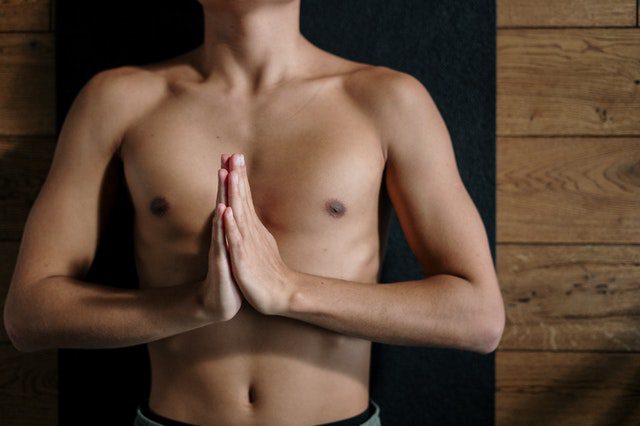
How To Tighten A Chest Binder
Many different people in the trans community might make use of chest binding (for example, nonbinary people or FTM people). In a previous article, we explored different ways to bind and settled on the fact that the safest way to bind your chest is by using a specially designed chest binder or normal sports bras. You might find this article helpful if you are still exploring options.
The purpose of a binder is to flatten and compress chest tissue without making it difficult to breathe. When you have a small chest, a binder or sports bra is usually more than enough to address gender dysphoria, but if you have a larger chest, you might still find that too much of your chest shows when you wear a binder. This leads many people to want to purchase a smaller binder or tighten their binder beyond what is advisable. Other people might even try to combine sports bras with their binders to make them fit snugly to the point of discomfort.
This article will address some of the concerns associated with wearing a binder that is too tight.

Finding The Right Size
The right size binder should be comfortably snug around your body without inhibiting breathing or causing pain. You should still be able to take a deep breath comfortably. The general rule of thumb is that you should be able to comfortably insert two fingers into the elastic binding against your skin. If you cannot do this, consider buying a larger size.
If your binder is too small, it can cause significant damage to your body. A binder that is too small can cause the following signs where it makes contact with your body:
- It can leave marks on your skin; the marks are usually angry, deep, and red and can be itchy or painful when the binder is removed.
- It can cause pinching or rubbing where it makes contact with your skin, which results in skin irritation.
- There will be tissue, possibly including breast tissue, spilling out of the top of the binder, maybe also the sides or bottom.
- There can be pain, soreness, or extreme discomfort associated with wearing a binder that is too small.
- If you are having significant trouble putting on the binder. Bearing in mind that binders are naturally tight and difficult to put on, there are limits to all things.
- If the binder is causing breathing problems like shortness of breath, whether immediately or during the day. You should not have trouble wearing your binder for eight-hour periods, five days a week.
If you measure your body and cannot find your exact measurements listed on the size charts, go for the option that is slightly bigger. Remember that your binder can be adjusted if it is too loose, and you should be able to adjust a slightly bigger binder to fit snugly, but a smaller binder only goes so far. Binders should be tighter than regular tank tops but loose enough to allow you to breathe easily.
We understand that it might cause dysphoria, but it is helpful to know your chest size. It will be helpful when buying a binder, measuring changes, and making surgery plans with your doctor. Knowing your measurements can help you find the right fit of binder without much difficulty. You can measure at home and use a chart suitable to your country to establish both back size and cup size. Knowing your bra size will make choosing a chest binder much easier. Remember, for a binder; you should also measure your shoulders; many people forget that and can then buy a binder that is too loose over their shoulders.
Styles of Binders
If you are new to the world of chest binding, you might not immediately realize that there are different styles of binders available. Finding the right binder style can be quite a journey; however, having different options available can be helpful. If one style does not work for you, you still have other options to try out. When you have tried a few, it is time to review options and decide which one gives you the best results. It is important that you can find an effective and satisfactory way to flatten and bind your chest.
If you do not like the idea of wearing something full-length and you are worried about overheating, the sports bra style can be ideal. They only provide chest compression. A slightly longer option is the mid-length style which reaches down to the belly button. These binders provide more surface area without being full-length and are less likely to be seen as some sort of bra.
The most popular style is the long shirt style which tucks into your pants. Some also provide compression over the stomach, while others do not. These binders will not be mistaken for bras. The last style works either with Velcro or a zipper which makes taking them off and putting them on much easier.
Regardless of the style, a surefire sign that your binder is too small is if you have limited or extreme difficulty taking a deep breath. You might find the other binding article helpful when deciding what kind of binding you want to do in the end.

Important Considerations for Long Term Binding
Something that is not often mentioned about chest binding is that if you bind for many years and do it often, it can eventually impact your top surgery outcome and can cause enough damage overtime to make surgeons hesitant to proceed with surgery. Therefore, if you want to have surgery eventually, you should take breaks regularly and take entire days off as much as you can.
The binder, even if it fits properly, will eventually weaken the elasticity of your skin and cause decreased blood flow due to prolonged compression. While these are not serious health problems on the surface, they will impact surgery outcomes and is something that trans men should be made aware of.
If you wear an ill-fitting binder for many years, you can damage the little muscles between your ribs, which will make it painful to take a deep breath and will result in a fluid build-up in your lungs over time.
Taking Care of My Binder
Due to the nature of the product itself, it will likely require replacement once a year. Without proper care, you might need to replace it more often.
Cleaning the Binder
Caring for your binder will likely depend on the brand and style as well as other factors like the climate that you live in, how often you wear it, how much you sweat, etc. Be careful of washing your binder too often – it can weaken the material, but not washing it often enough can cause skin irritation and cause the binder to discolor or start to smell.
It is always best to follow the instructions provided when you purchase your new binder. The material used to make the binder will impact how it needs to be washed, etc. The manufacturer includes cleaning instructions when you make a purchase. If instructions on drying are not included, it is best to hang your binder up to dry and not to put it in a dryer.
Can I Shrink My Binder?
It is not advised to attempt to do this. If your binder does not fit, you can try to exchange it or purchase a new one and sell yours as an unworn used binder. Some people will buy used binders if they have not been worn.
If you want to keep the one you purchased for whatever reason, the best way to resize it is to use the adjustment straps already on the binder or the sow it smaller. But always make sure that it is not too tight.
You should never try to shrink your binder with heat. The plastics inside the fabric that make it elastic will melt, and the material will lose its elasticity and will soon break. This is also why you should not wash it with hot water and should not dry it in a hot dryer. Any of these sources of heat will impact the overall life of your binder.

A Quick Word on Appropriate Language
If you are helping a friend out with information about binders we want to quickly bring your attention to the appropriate language. Most people who are unfamiliar with transgender issues might make innocent mistakes in what they call things that might cause their friend or family member to experience dysphoria.
The first rule when talking about binders is to never refer to ‘breasts’. Your friend does not have ‘breasts’; they have a chest. Some people might also be uncomfortable with the term ‘breast tissue’ although this is medical and refers to male or female chests. Specifically, breast tissue is a type of tissue that can become cancerous, where other chest tissues will likely not become cancerous, and even cisgender men have this type of breast tissue.
That being said, you should be making a concerted effort not to refer to someone’s chest as « breasts ». At this point in time, the concept is still too heavily gendered. Also, try to avoid other gendered languages.
Frequently Asked Questions
Why is it wrong to bind with ace bandages?
Elastic bandages are designed to contract with movement. So the more you move, the tighter it becomes, and it can lead to respiratory problems during the course of the day.
If I cannot afford a binder or binding tape, can I use duct tape instead?
We do not advise the use of duct tape for the purpose of binding. It can cause extreme discomfort upon removal and can irritate the skin. You could alternatively use a regular tank top to bind. We provided detailed instructions on how to use a regular tank top for binding in a previous article. A regular tank top is a suitable option if you are worried about the cost of a binder. Many people avoid using a tank top because it can also cause a « uni-boob » look which is not what you are looking for when trying to bind.
Why should I not wear a binder for long periods of time?
Over time wearing your binder causes damage to chest tissue and skin. They are designed to fit snugly, and this can affect blood flow without causing pain, soreness, or extreme discomfort. Although you will still breathe easily if your binder fits properly, prolonged compression will eventually affect your breathing. The small muscles between your ribs can atrophy, which can make breathing painful or difficult.
These kinds of side effects are common when wearing binders for long periods of time but are greatly diminished when you take breaks in-between.
If I have a flat chest, do I need to wear a binder?
You should only be wearing a binder if you experience dysphoria associated with your chest. If you do not feel that your chest is visible through your clothing, or if it does not bother you, there is no reason to wear a binder.
If your nipples are a concern, you can simply wear something like a sports bra. You should never feel pressured to bind your chest if you are uncomfortable doing so.
How do I put on a binder?
It can be difficult to put on a binder, especially if they are not the vest type. Some of them, like the ones that look like a tank top, require you to step into them like pants and then pull them up over your hips, which can be a tight fit, so take care doing this lest you pull too hard and your binder breaks.
Your binder is made of spandex, and this causes it to stretch quite a bit, but if you are having a lot of trouble pulling it over your hips, arms, or shoulders, you should probably consider switching to a vest style instead.
It is perhaps a good idea to watch some instructional videos on how to put on and wear a binder. These can easily be found on YouTube.



